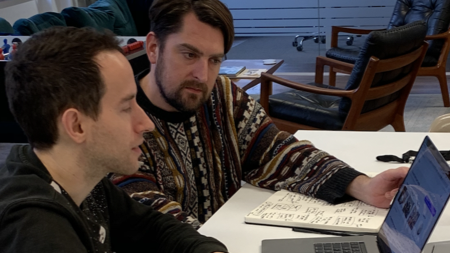To make Usability Testing understandable for everyone, here’s a quick guide to explain what it is, and 4 steps to follow in order to gain the most valuable insights.
What is usability testing?
Usability testing is a method used to evaluate whether or not your product meets the expectations of your customers. The tests take place with real users of your product who reflect the personas you have defined as your target audience. These tests measure how intuitive / easy it is to use your website or application by asking them to complete specific tasks in a controlled environment.
The goal is to optimise the customer journey and maximise conversion. To do this, you need a deep understanding of what's working and what could be improved.
Testing throughout the product life-cycle reduces the risk of building a product that does not meet your target audiences’ requirements, and as the product matures it helps to benchmark and improve conversion rates and time to complete tasks.
Researchers moderate the testing sessions and assess how users interact with the product as they complete tasks, collecting quantitative and qualitative data that is collated and analysed to identify trends.
Depending on your product, you can focus on different areas that could be improved such as:
-
Flow through acquisition journey
-
Conversion to desired action / purchase / registration
-
Engagement
-
Basket flow

What are the benefits?
The key advantages to UT can be split between benefits for the company and benefits for the users:
Benefits for the company:
-
You can get a direct insight from the target customers
-
Issues and potential problems can be resolved before the product is launched
-
The risk of product failing is minimised
-
Conversion rates will be optimised
-
The likelihood of usage and repeat usage increases
-
User engagement with you product will also rise...
-
...And as they are more likely to return - so does retention
-
Your ROI will be increased
Benefits for your customers:
-
They find what they need on your website / app without struggling or feeling lost
-
They feel like the website / app answers the 5 Ws and H (who-what-when-why-where-how)
-
The user doesn’t spend much time navigating through the site / app to find what they are looking for
-
The customer enjoys your product and is willing to come back
4 steps to usability testing
Step 1: DEFINE
The initial stage is to identify the key areas which are valuable to test to meet your goal of increasing key conversion.
-
Create hypothesis and testing criteria that will set the controls and measurement framework
-
Identify key journeys and user tasks that will be conducted by users during the tests
-
Write test scripts that users will follow when being tested
Step 2: RECRUIT
Be clear who your target audience is and then recruit users on this basis. The magic number of users is 5 per persona.
Why is that? The answer is simple: If you have 3 test users, you’ll catch about 65% of the problems. With 4 users you’ll catch 75%, and with 5 you’ll catch 85%. Once you cross the 5 users and begin to add more, the increase of issues that you’ll uncover reduces. That is due to overlapping user experiences.
So for example, once you have collected issues from the first user, the second user might come across the same ones and so on with the third one. Users are different and don’t react in the same way so obviously you will find something new that the first or second user didn’t observe but the amount of new data collected decreases with each test user and flattens out most prominently at 5 test users, making 5 users the right size for the right value.
Recruitment can be done in house or by a third party research company.
The users can be either owners of your product / service or owners of competitor products / services.
Step 3: TEST
This is the actual test phase. The interviews can be done face-to-face or remotely.
The questions are now defined and users recruited, so be ready to prepare a detailed plan of the interview.
Here are some recommendations:
-
Make the users feel comfortable if they come to your office. Introduce yourself and explain what you would like them to do and what the reason behind this is.
-
Let them know that there is no right or wrong answer so anything they say can be useful.
-
Have them think out loud while they go through different tasks. This way we can really understand what struggles they might have or what they would rather see on a certain page for example.
-
Make them carry out controlled usability tests on different devices and different operating systems.
-
Ask them to perform specific tasks through key journeys and understand how the product performs.

Step 4: SYNTHESISE
Once testing is complete, the team compiles a list of findings and summarises recommendations in a report, including potential implementation changes or longer term testing options for the website / app.
In this phase it’s is very important to analyse the quantitative and qualitative data gained from the interviews and take actions accordingly. So for example:
-
Watch back recordings, analyse notes and collate results to identify trends
-
Identify pain points and where users are having problems completing tasks
-
Create a report detailing recommendations for improvement specifically focusing on how we can increase conversion
The goal is not about writing an extensive report but outlining the most insights discovered and what the next steps forward should be.
This can really be your chance to make your product more efficient, enjoyable and increase conversions.

Sometimes what designers, developers, copywriters and product managers think works best is not necessarily what your customer wants, so it’s important that those customers are always your focal point and given extensive attention at each stage of your product process.
That way you will get a product that your customers actually want and to which they will return - giving you maximum ROI and super satisfied stakeholders.












